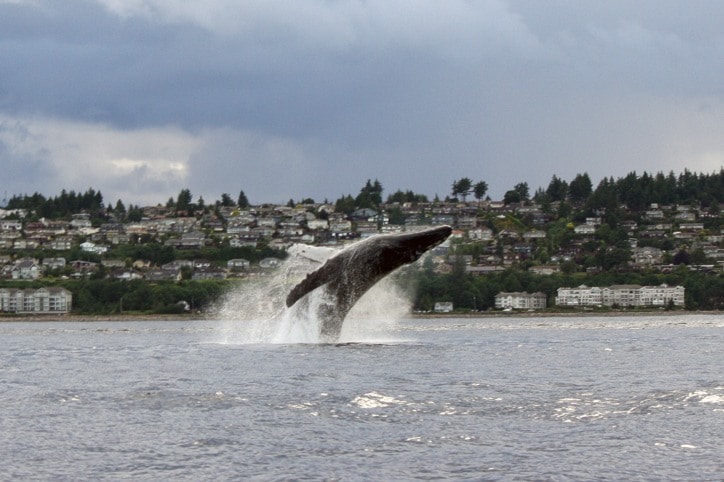Many local readers likely took note of a remarkable photograph of a humpback whale breaching in front of Campbell River.
As someone who has been working to ID the humpbacks in our area, I almost jumped as high as that whale when I saw the photo!
I took up contact with the photographer, Caylin Dubé of the Oak Bay Marine Group, hoping she might have images from the June 24 encounter that would allow me to determine who the humpback was.
Caylin was extremely generous with her photo and wanted to know who the whale was as much as we at the Marine Education and Research Society (MERS) did.
My hunch was quickly confirmed. The ID work of the last eight years allowed us to conclude the breaching whale was BCY0291 (DFO catalogue number) who we nicknamed KC — short for Kelp Creature, but the origin of that name is too long a story to explain here!
We’ve known this whale since 2002 when it was a first-year calf in an area off the waters of Telegraph Cove for which this whale has extremely strong site fidelity.
Since last year, however, KC has also been sighted around Campbell River, only to quickly turn around and swim back to the waters around Telegraph Cove.
We have theories about why it might do this, but generally it’s an additional mystery.
Although humpbacks are long-studied and easy to identify as individuals, there’s still much we don’t know about the giants that breathe the air we do.
For example, KC likely belongs to the population of humpbacks that go to Hawaii to breed in the winter, yet no one knows how the whales find these islands.
Caylin’s photos also revealed there was a second humpback with KC.
Even without a photo of the underside of the tail — the easy way to identify humpbacks as individuals since the markings and trailing edge of each whale is unique — MERS dedication to also cataloguing flank photographs of the humpbacks allowed us to determine the second humpback was Arial (BCY0767) who we’ve known since 2007 as a first-year calf in our area.
Interestingly these two whales have the same mother, but since humpback calves only stay with their moms for a year to our human knowledge they would not know they were siblings.
That these two humpbacks sometimes travel together could be coincidence or not — yet another whale of a mystery to try to solve. That we at MERS were able to identify the whales from Caylin’s photographs — taken from well beyond the 100-metres boats must stay away from whales — is testament to the value of the great community effort to understand the return of humpback whales to our waters.
We have ID photographs dating back to the 1980s thanks to the relentless vigilance of Dr. Alexandra Morton to understand our marine ecosystem.
Many other ID photographs have been contributed by the whale-watching community from Port Hardy to Campbell River.
Of special note for the consistency and longevity of their contributions is Stubbs Island Whale Watching.
For the work of the Marine Education and Research Society, including our efforts to understand the threat of humpbacks becoming entangled in fishing gear, log onto: http://www.mersociety.org” www.mersociety.org.
Jackie Hildering is a biologist, avid scuba diver, and marine educator who lives in Port McNeill http://www.themarinedetective.ca.
